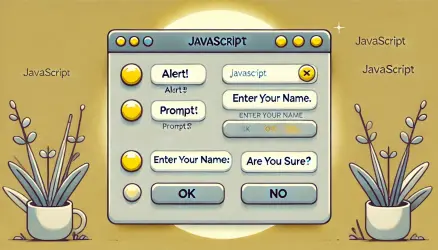JavaScript Variables and Constants are fundamental to any script. They are used to store data values that can be retrieved and manipulated later. This post will explore how to declare and use variables and constants in JavaScript with practical examples.
What Are JavaScript Variables and How to Declare Them?
In JavaScript, variables are like containers that hold information. You can declare a variable using one of three keywords: var, let, or const. Let’s look at each one:
Using var
The var keyword is the oldest way to declare a variable. It has a function scope, meaning it’s accessible anywhere within the function where it’s defined.
var name = "John Doe"; // Declare a variable
console.log(name); // Output: John Doe
var name = "Jane Doe"; // Re-declare the same variable
console.log(name); // Output: Jane Doe
Note: Re-declaring variables with var can lead to unexpected behavior, especially in large scripts, since the variable can be unintentionally overwritten.
Using let
The let keyword is a newer and better way to declare variables. It has block scope, meaning it’s only accessible within the block (e.g., within curly braces) where it’s defined.
let age = 25; // Declare a variable
console.log(age); // Output: 25
age = 26; // Update the variable
console.log(age); // Output: 26
// let age = 30; // Error: You cannot re-declare a variable with let in the same scope
Using const
The const keyword is used to declare a constant, meaning the value cannot change after it’s assigned. Like let, it also has block scope.
const birthYear = 1995;
console.log(birthYear); // Output: 1995
// birthYear = 2000; // Error: You cannot reassign a constant
Note: If the value assigned to a const is an object or array, its properties can still be changed:
const person = { name: "John" };
person.name = "Jane"; // Works
console.log(person.name); // Output: Jane
Tip for Beginners: Always use
constunless you know the value will change. It helps prevent accidental changes and makes your code easier to understand.
Understanding Variable Scope
Scope determines where you can access your variables in your code. Let’s break it down:
- Global Scope: Variables declared outside any function can be used anywhere in your code.
- Function Scope: Variables declared with
varinside a function are only available within that function. - Block Scope: Variables declared with
letorconstare only available within the block they’re defined in.
var globalVar = "I am global";
function testVar() {
var functionVar = "I am a function variable";
console.log(globalVar); // Accessible
console.log(functionVar); // Accessible
}
if (true) {
let blockVar = "I am a block variable";
console.log(blockVar); // Accessible inside the block
}
testVar();
// console.log(functionVar); // Error: functionVar is not defined outside the function
// console.log(blockVar); // Error: blockVar is not defined outside the block
In the above example, globalVar is accessible globally, functionVar is accessible only within the testVar function, and blockVar is accessible only within the block where it is declared.
Key Differences Between var, let, and const
This following table compares the behavior of JavaScript’s var, let, and const by key properties such as scope, re-declaration, and re-assignment. It also highlights hoisting behavior and their use in loops, helping developers choose the appropriate keyword based on specific use cases.
| Property | var | let | const |
|---|---|---|---|
| Scope | Function-scoped | Block-scoped | Block-scoped |
| Re-declaration | Allowed | Not allowed | Not allowed |
| Re-assignment | Allowed | Allowed | Not allowed |
| Hoisting | Yes, but initialized with undefined | Yes, but in Temporal Dead Zone (TDZ) until declared | Yes, but in Temporal Dead Zone (TDZ) until declared |
| Initialization | Optional | Optional | Required |
| Use in loops | Not suited for loops due to scope issues | Better suited for loops due to block scope | Works in loops but value cannot be reassigned |
Hoisting is a JavaScript mechanism where variable and function declarations are moved to the top of their containing scope during the compile phase, making them accessible before their actual declaration in the code. However, only the declarations are hoisted, not the initializations.
Rules for Naming JavaScript Variables
Naming variables in JavaScript follows specific rules to ensure clarity and avoid errors. Here are the key rules with examples:
- Begin with a Letter, Underscore, or Dollar Sign: Variable names must start with a letter, an underscore (_), or a dollar sign ($).
let name = "John";
let _private = "secret";
let $price = 20;
- Case-Sensitive: Variable names are case-sensitive, meaning
nameandNameare different variables.
let age = 30;
let Age = 25;
- No Reserved Keywords: Variable names cannot be reserved keywords like
var,function, orclass.
// let var = "value"; // Error: var is a reserved keyword
let variable = "value"; // Correct
- Use CamelCase for Multi-word Names: Use camelCase for variable names that consist of multiple words.
let firstName = "John";
let totalPrice = 50;
Following these rules ensures that your code is readable and avoids common errors related to variable naming.
Best Practices
Here are some best practices when using variables and constants in JavaScript:
- Use
constby default, unless you know the value will change. - Use
letfor variables that will change. - Avoid using
varas it has more complicated scoping rules and can lead to bugs. - Always declare variables before using them to avoid hoisting issues.
Generally, using const is a good practice because it ensures the variables you define cannot be reassigned, leading to fewer bugs and a more predictable codebase. Only use let when you know the variable’s value will change, such as in loops or conditional statements. This makes your intentions clear and improves code readability.
Avoid var due to its function-scoped nature and potential for hoisting issues, which can lead to unexpected behavior. Block-scoped let and const provide more reliable behavior and are easier to manage. Finally, always declare variables before using them to prevent hoisting-related bugs and improve code clarity.
Conclusion
Variables and constants are fundamental to programming in JavaScript. Understanding the differences between var, let, and const, as well as their scope, is crucial for writing clean and efficient code.
For a deeper dive into the most frequent errors and how to prevent them, check out our post on How to Avoid Common Mistakes When Using Variables in JavaScript. This guide will help you write cleaner, more reliable code.
By following best practices, you can avoid common pitfalls and ensure your code is robust and maintainable.


